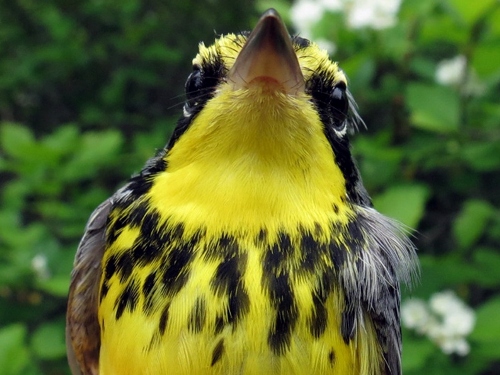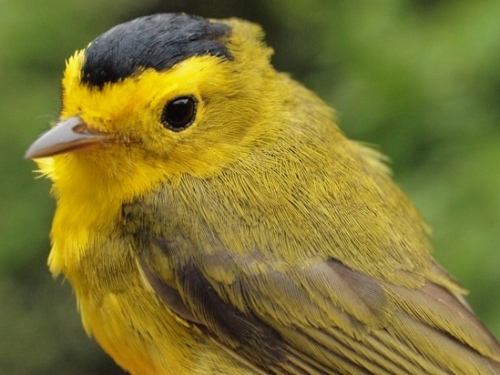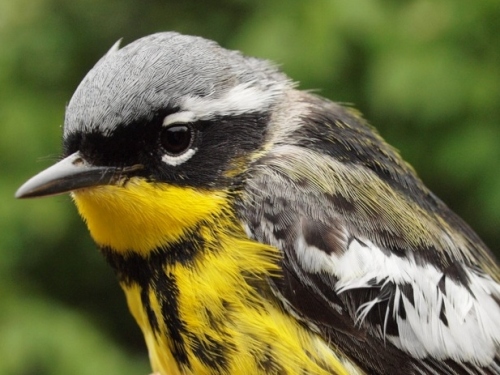|
|
THIS WEEK |
THIS SPRING |
2013 TOTAL |
SITE TOTAL |
|
# birds (and species) banded |
132 (28) |
761 (68) |
1129 (73) |
42641 (112) |
# birds (and species) repeat |
55 (18) |
204 (31) |
275 (33) |
8256 (70) |
|
# birds (and species) return |
11 (6) |
101 (23) |
133 (27) |
1342 (38) |
|
# species observed |
94 |
144 |
148 |
208 |
|
# net hours |
324.8 |
2683.8 |
2738.8 |
72028.5 |
|
# birds banded / 100 net hours |
40.6 |
28.4 |
41.2 |
59.2 |
|
|
Note: table does not include nocturnal banding (owls) |
Bander-in-charge: Simon Duval, Gay Gruner
Assistants: Christine Barrie, Nicolas Bernier, Marc Boisvert, Salomé Bonnefoi, Cindy Bouchard, Luke Currin, David Davey, Rui de Jesus, Barbara Frei, André Gagné, Jo-Annie Gagnon, Alison Hackney, Lisa Keelty, Barbara MacDuff, Betsy McFarlane, David Oldacre, Catherine Russell, Marilou Skelling, Fernanda Triconi
Notes: Week 9 was disappointingly quiet, with just under half as many birds banded as in week 8, in part because rain limited banding effort to two full days and three partial ones. On the other hand, diversity was impressive. Another 8 species were banded this spring, taking the spring total to 68 species - two more than the previous record for the season, set in 2009 and matched in 2012. The new additions this week were Yellow-bellied Flycatcher, Red-eyed Vireo, Gray-cheeked Thrush, Swainson's Thrush, Brown Thrasher, Cedar Waxwing, Blackpoll Warbler, and Indigo Bunting. Three of these species (the flycatcher and the two thrushes) were also seen for the first time this spring, as were another five: Sora, Eastern Wood-Pewee, Philadelphia Vireo, Orange-crowned Warbler, and Scarlet Tanager. That raised the season total to 144, well above average and only behind the 148 recorded to this point in 2006.

A front view of a male Canada Warbler, one of Canada's threatened species.
(Photo by Gay Gruner)
|
This week’s
top 10 [last week's top 10 in brackets]
#
individuals banded |
mean # individuals observed daily |
1. Magnolia Warbler (14) [1] |
1. Red-winged Blackbird (33) [2] |
1. Blackpoll Warbler (14) [-] |
2. American Crow (18) [3] |
1. Northern Waterthrush (14) [4] |
3. Yellow Warbler (13) [4] |
4. Tennessee Warbler (11) [2] |
4. Tennessee Warbler (8) [-] |
5. Traill's Flycatcher (10) [-] |
5. Common Yellowthroat (8) [-] |
6. Wilson's Warbler (9) [-] |
6. Baltimore Oriole (8) [5] |
7. Common Yellowthroat (7) [8] |
7. Song Sparrow (7) [-] |
8. Gray Catbird (6) [7] |
8. Cliff Swallow (7) [5] |
8. Cedar Waxwing (6) [-] |
9. Blackpoll Warbler (7) [-] |
8. Yellow Warbler (6) [3]
|
10. American Goldfinch (6) [10] |
|
Warblers typically dominate the banding results in week 9, and this year was no result even though the numbers were relatively modest. A three-way tie for top spot included last week's dominant species (Magnolia Warbler) as well as new arrival Blackpoll Warbler, and a continued surge of Northern Waterthrushes - enough to set a new spring record for the species. Tennessee Warbler slipped back to fourth place. For the third year in a row, Traill's Flycatcher reached double digits in week 9; as usual most of these are likely Alder Flycatchers, but species ID was not determined conclusively for any of them. The remainder of the top ten includes Gray Catbird, Cedar Waxwing, and another three warblers - more Common Yellowthroats and Yellow Warblers, plus the first of this year's Wilson's Warblers.
The list of the top birds observed shows how much numbers dropped this week compared to last. Ring-billed Gull was the top species last week, but didn't even make the top ten this week. Instead, Red-winged Blackbird, American Crow, and Yellow Warbler all moved up one spot to become this week's top three, although all of them were much less numerous than in week 8. Three more warblers were common enough to appear in the top ten - Tennessee, Blackpoll, and Common Yellowthroat. Remarkably, this was the first time ever that five warbler species appear in the top ten list for species observed in spring, although as noted this is probably more due to the low numbers of other species.
|

Wilson's Warbler, one of the latest spring arrivals, finally starting to trickle in last week, and with numbers building this week.
(Photo by Simon Duval)
|



